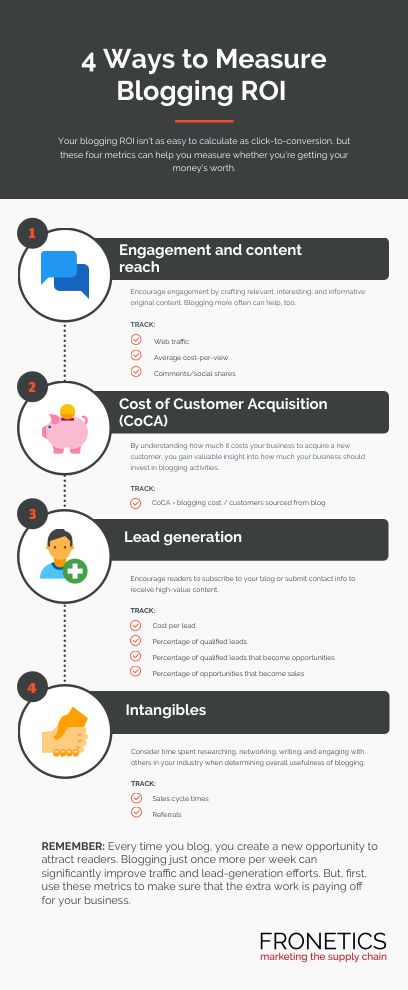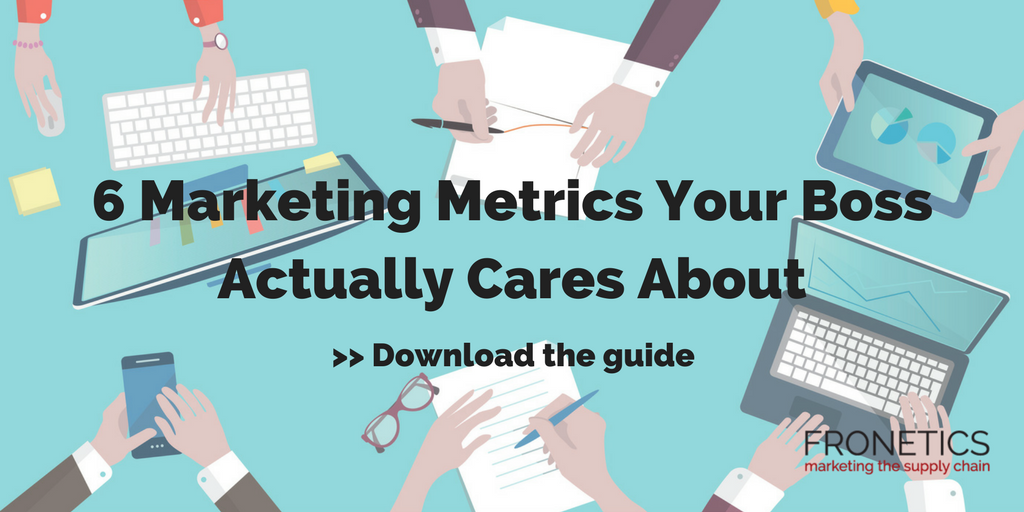
by Fronetics | Mar 22, 2018 | Blog, Content Marketing, Marketing, Strategy
Your blogging ROI isn’t as easy to calculate as click-to-conversion, but these four metrics can help you measure whether you’re getting your money’s worth.
“Exposure and engagement is key when it comes to measuring ROI. Simply publishing a blog post isn’t enough of a success. You have to go deeper and pay attention to things like social share metrics, engagement metrics, and actual conversions that can be tied to the content you’re producing.” — Colin Mathews, Co-Founder, Content Marketer
Why do you blog? It seems like a simple question, but the answer has a huge impact on the content you produce and the outcome of your efforts.
As with all aspects of your business, you should give the return on investment of your content marketing efforts ample attention. That is especially true for blogging ROI, if generating new business is indeed one of the reasons you blog in the first place.
With 53% of marketers saying blog content creation is their top inbound marketing priority, it’s crucial that you’re making sure your hard work is worth the time and money you’re spending on it.
Let’s face it, blogging isn’t free. Creating relevant and interesting content for your blog is highly demanding. The people working to sustain your blog and engage with new audiences through your content are spending valuable time and money. If you want to ensure that these efforts are producing results, it’s imperative to calculate the impact of your blogging on your bottom line.
Calculating blogging ROI isn’t as straightforward as other ROI analysis. You simply can’t rely on click-to-conversion data to give you the full picture. But your blog achievements can be measured in other ways. Here are four categories to measure the effectiveness of your blog.
Infographic: 4 ways to measure your blogging ROI


(Made with Canva)
Final Thoughts
While it can feel a little unwieldy to measure blogging ROI, keeping a strong focus on your goals and objectives will help to lend weight to metrics that ultimately matter the most to you and your business.
Whether you’re looking to generate leads or attract first-time site visitors, your blog is a great place to boost engagement and expand your reach. Focus on making your blog as valuable as possible for your target audience, and you’ll be able to measure the fruits of your labor.
How does your company measure blogging ROI?
Related posts:


by Fronetics | Mar 15, 2018 | Blog, Content Marketing, Logistics, Marketing, Strategy, Supply Chain
Here are four simple steps to help you measure your company’s content marketing ROI and the success of your strategy.
Lean-startup pioneer Eric Ries said, “The only metrics that entrepreneurs should invest energy in collecting are those that help them make decisions.” In other words, measure the things that will tell you if an effort was profitable so you know where to put your time and money.
But most companies aren’t using the right metrics to track their content marketing ROI. For example, 83% of B2B enterprise companies (over 1,000 employees) use web traffic as their main metric for measuring content marketing ROI. A spike in homepage hits could be the result of your hard work, but it could also be ghost spam, or even both! So clearly, web traffic isn’t the most reliable metric.
Content marketing ROI is harder to quantify than checking a few quick numbers. But don’t give up hope. In the article How to Measure Content Marketing ROI: A Simple 4 Step Process, marketing consultant Bill Widmer breaks down a simple, four-step process that will quickly and effectively measure your content marketing ROI.
What is content marketing ROI?
Content marketing ROI is how much revenue you gain from content marketing in comparison with what you spend on creating and distributing content. It’s an actual percentage that shows how much revenue you gained vs. how much money you spent. And for a lot of businesses (and bosses), this percentage is very important. They want you to be able to prove that the marketing dollars that are going into your content marketing strategy are actually pulling in new business.
Every company has specific key performance indicators (KPIs) that help shape their marketing strategies. Here at Fronetics, we believe that your content marketing strategy should take these KPIs into consideration when thinking about your ROI:
- Website traffic
- Leads generated
- Conversion rate
- Direct sales
Obviously content marketing has more benefits than these four KPIs demonstrate — including better customer retention, brand awareness, and improved SEO — but to begin to measure your ROI, let’s focus on these four main points.
Measure content marketing ROI in 4 simple steps
1. Download your reverse goal path data.
Andy Crestodina, co-founder and CMO of Orbit Media, suggests:
- Go to your analytics dashboard. Set the date range for at least a year.
- Go to Conversions > Goals > Reverse Goal Path.
- Add a filter like “/blog” so only blog posts show up.
- Sort by Goal Completions.
After this step, you’ll be able see which of your posts have driven the most conversions. But you can’t stop there. These are simply conversion numbers. We want those numbers to become conversion rates, so let’s keep going.
2. Download your pageview data.
In order to calculate a conversion rate, you need to know pageviews. Here’s how to get that information:
- Go to Content > Site Content > All Pages.
- Filter with “/blog” to get only blog posts.
Download this data into the spreadsheet from step one.
3. Get your conversion rate.
Now here’s a little math for you. Divide the data in the “conversions” column by the number in the “unique pageviews” column. This will give you your conversion rate per blog post.
This will show you what your best-performing pieces of content are, and what posts need to be updated to gain more views and shares.
This information will give you valuable insight into the topics that your target audience are reading about and how you can better plan for high-ranking content in the future.
If you have posts or pages that are older — like over a year — and they haven’t gotten any views or conversions, it’s time to think about reworking them to have more appeal to your target audience.
For your actual percentage, you’ll need to calculate how many of these leads have converted to sales.
4. Calculate content marketing ROI based on lead conversions.
Here’s where things get a little more complicated, but still very manageable. You need to start putting tags on your leads according to the content they came from.
You can use programs like WordPress or Blogger to help you automatically tag any leads that came from a specific form. Assuming the form correlates to a single blog post, you will know that any leads with that tag came from that post.
You can also connect your leads with a CRM, such as HubSpot or SalesForce, and track which leads came from specific emails. These programs easily integrate with your analytics and email marketing platforms for up-to-date numbers and data.
Related posts:


by Fronetics | Jan 18, 2018 | Blog, Content Marketing, Marketing
With a high correlation between publishing frequency and web traffic and leads, you need to publish blog content more often to boost lead generation efforts.
Here are Fronetics, most of our clients are sales-driven. If a client’s business goals include earning leads, we are sure to align the client’s content strategy with that objective. One of the most effective ways to increase the number of leads your website attracts is to increase the frequency with which you publish content.
It seems simple, right? The more often you publish blog content, the more traffic and leads you’ll get. Search engines consider posting frequency in their rankings. What’s more, every time you post, you create a new opportunity to be found, shared, and linked by other sites.
The more you publish blog content, the more they’ll read.
Recent studies have shed light on the relationship between publishing frequently and increased web traffic and leads:
- HubSpot’s benchmarking data shows that blogs that publish 16+ times per month receive 3.5x more traffic than those that publish weekly or less often.
- From the same report, companies that publish 16+ blog posts per month get about 4.5X more leads than companies that publish between 0-4 monthly posts.
- Curata’s survey of 400+ marketers found that 90.5% of the most successful business blogs (over 10,000 views per month) publish at least once a week.
But we know there are challenges to posting frequently.
Publishing blog content frequently comes with its own set of challenges. Time is the biggest obstacle we hear from our clients. Good blogging should be more of a conversation than a press release, but dialogue takes time to create. It can also require additional time to respond to readers’ questions and comments.
The other big challenge is quality. When you’re producing more and more content, it’s easy to let the quality of your pieces slip. You want to make sure the content on your blog is relevant, informative and engaging. It can be difficult to balance publishing frequently and maintaining value and quality.
So how do you find the balance?
Start small. We often encourage our clients to publish blog content just one more time per week. Though some are skeptical of the impact this will have on their traffic and lead-generation efforts, they inevitably find that such a small step can make a big difference.
And no, you don’t have to be a Fortune 500 company to start seeing the impact of your blog posts on your leads. The HubSpot benchmarking report found that increasing posting frequency had the biggest impact on smaller businesses: Companies with 10 or fewer employees that published 11+ posts per month had almost 3X more traffic than companies publishing 0-1 monthly posts, and about 2X as much traffic as those publishing 2-5 monthly posts.
Take one client of ours for example. We suggested moving from publishing one post to two posts per week. The client was unsure this would have any impact, especially for a company in the supply chain industry. But the immediate results spoke for themselves. After just one month, traffic increased by 23%, sales leads doubled, and the client landed a new customer.
Try our suggestion and publish blog content one more time per week, then let us know how it works out for you. We’d love to hear about your success.
Related posts:
SaveSave

by Fronetics | Oct 30, 2017 | Blog, Content Marketing, Marketing, Strategy
Relationships take time and trust to fully develop, and lead nurturing is no different.
Before I got married in 2009, I spent most of my twenties in the dating pool. I would meet someone. We would exchange phone numbers. And through a series of texts and calls, we would eventually meet for dinner. One dinner would lead to another and possibly another.
Lead nurturing isn’t all that different. When you first meet your lead, chances are they won’t be ready to purchase right away. In fact, 63% of consumers requesting info on your company today will not purchase for at least 3 months. But if you spend time establishing a relationship and building trust, the moment your lead is ready to purchase, you’ll be miles ahead of your competition.
As more and more buyers are engaging with brands before they are ready to purchase, an essential function of any marketing department is lead nurturing. That is, moving leads through the sales funnel by leveraging what you know about their needs and online behavior. Marketing software company Marketo describes lead nurturing as being “personalized, adaptive, and able to listen and react to buyer behavior in real time.”
Lead nurturing, like dating, takes time to establish a relationship and move toward the ultimate goal of converting from lead to customer. Here are five tips to help nurture these relationships.
5 lead nurturing tips
1. Make a good first impression
You would never go on a date without looking and feeling your best. The same should be true for your website, your company’s online home. As part of your preparation for a lead nurturing campaign, review your website and make any necessary modifications so that it presents the best digital representation of your business. Beyond increasing conversions, having an attractive, modern website that’s free of broken links and out-of-date contact information establishes your company as a trusted resource for information.
2. Make a plan ahead of time
Where are you going to dinner? Are you making a reservation? What are you doing after dinner? Preparing for a date requires some thought and planning, especially when considering your date’s preferences. Content selection requires the same forethought. The decision about what content you’ll offer your leads will be guided by the preferences and needs of your prospects. Create content that is relevant to your leads, and make sure to identify appropriate channels of distribution in order to extract maximum value from your content.
3. It takes time
Dating tends to happen in stages that occur over weeks and months. Similarly, the lead nurturing process is intended to push content to leads in a linear fashion, with the ultimate goal being that they’ll emerge as customers. Once you’ve moved past the first date, so to speak, you’ll want to decide how to continue romancing your leads. To do that, align content with where your leads happen to be in the buyer’s journey. Leads will enter and exit your lead nurturing campaign at different points, and that’s okay. Just be certain that your content is relevant to leads in their specific stage. Regardless, each nurturing touch should be focused and specific and include a call-to-action to promote advancement in the buyer’s journey.
4. Communication is key
As with any relationship, the foundation of lead nurturing is communication. Being able to hold meaningful conversations builds a genuine interest and helps improve any relationship. In other words, don’t view the lead nurturing process as a way to blast your prospects with promotional information or marketing materials; treat it as a dialogue. The best lead nurturing campaigns are designed to help you learn as much about your leads as you would have them learn about your company.
5. Show your interest and appreciation
We all want to feel appreciated, and the same is true for your customers and leads. Whether it’s by showing gratitude to current customers for their continued support or showing appreciation to leads for their download, saying thank you goes a long way in building connections and professional relationships.
In our personal and professional lives, we want relationships built on trust over time. A successful lead nurturing campaign is constructed on these same principals. When you plan ahead, don’t rush the process and create opportunities for meaningful communication, the possibilities are endless.
Want to learn more about lead nurturing? Check out these 30 tricks and tips that will change the way you nurture leads.
Related posts:


by Fronetics | Sep 11, 2017 | Blog, Content Marketing, Marketing, Social Media, Strategy
Social prospecting can help logistics and supply chain companies identify and engage with leads on social media in a genuine — and highly effective — way.
Social media should be an integral part of your marketing strategy. You know it helps build brand awareness, gather market intelligence, discover customer problems, and influence purchasing decisions. But your lead generation efforts should also include the use of social platforms. It’s a practice called social prospecting, which can be highly effective in identifying new prospects.
What is social prospecting?
With more than 2 billion monthly active users on Facebook and over 328 million monthly active users on Twitter, smart marketers know there’s more potential than ever to use social platforms to get their name out there, spread their content, and draw more people to their site. Hey, it’s your job to make people aware of what your company can offer, right? Right.
That’s where social prospecting comes in. It involves scouring the social web, identifying potential prospects for your business, engaging them with content, and getting those potential prospects to your sales team. “Social prospecting is the art of listening to people, not mentions or keywords,” writes Maggie Hibma for HubSpot.
Social media isn’t just for recreational purposes anymore. More than half (53%) of B2B buyers report using social media to research purchases, in fact. Social prospecting allows you to be proactive in finding all of the considerable number of social-media-using prospects who are looking for you, too.
But as with any initiative, social prospecting requires commitment. In order to find new leads, social prospecting needs to become a part of your daily routine. The end results will be quality leads that are already committed to your brand because of the connection you have created through social channels.
Creating positive impressions
The secret behind successful social prospecting is creating and distributing content that shows that you and your company genuinely care about your clients and prospects. It’s about ditching the ‘sales’ game and working to establish your brand as an industry leader that has a connection to your community and a lot of valuable insight to share.
Make your content about your target consumers: What do they need to know, struggle with, or want to learn more about? By distributing this content across social channels to foster sharing, conversation and engagement, you’ll gain influence with your audience (and their networks) and make a positive impression.
Prospecting vs. spamming
The definition of spam is “indiscriminately.” It means “in a random manner” or “in a way that does not show care or judgment.” This is the opposite of how social prospecting should work. The connection that you create with your prospects should be anything but random.
Think about the number of possible prospects on social media right now. Facebook just topped 2 billion active users monthly, and Instagram is pulling in over 250 million daily active users. These massive numbers scream opportunity — but only if you are putting your time and effort into the right people, on the right channels, at the right time.
Sounds complicated? It doesn’t have to be. If you already have a social media presence, that’s step one.
Fronetics’ recently updated Social Prospecting Workbook guides you through using social listening to generate new leads for your business. We’ve identified the quickest way to find potential customers on Twitter, Facebook, LinkedIn, Pinterest, and Google+. Every worksheet includes:
- Short preparatory work to make the actual prospecting easy
- Visual instructions on how and where to find prospects
- Pro tips that will help you get the best results
- Prescriptions (Marketing Rx) for success
- Take-home exercises for follow-up prospecting
Download it now, and let us know what you think!

Related posts:










